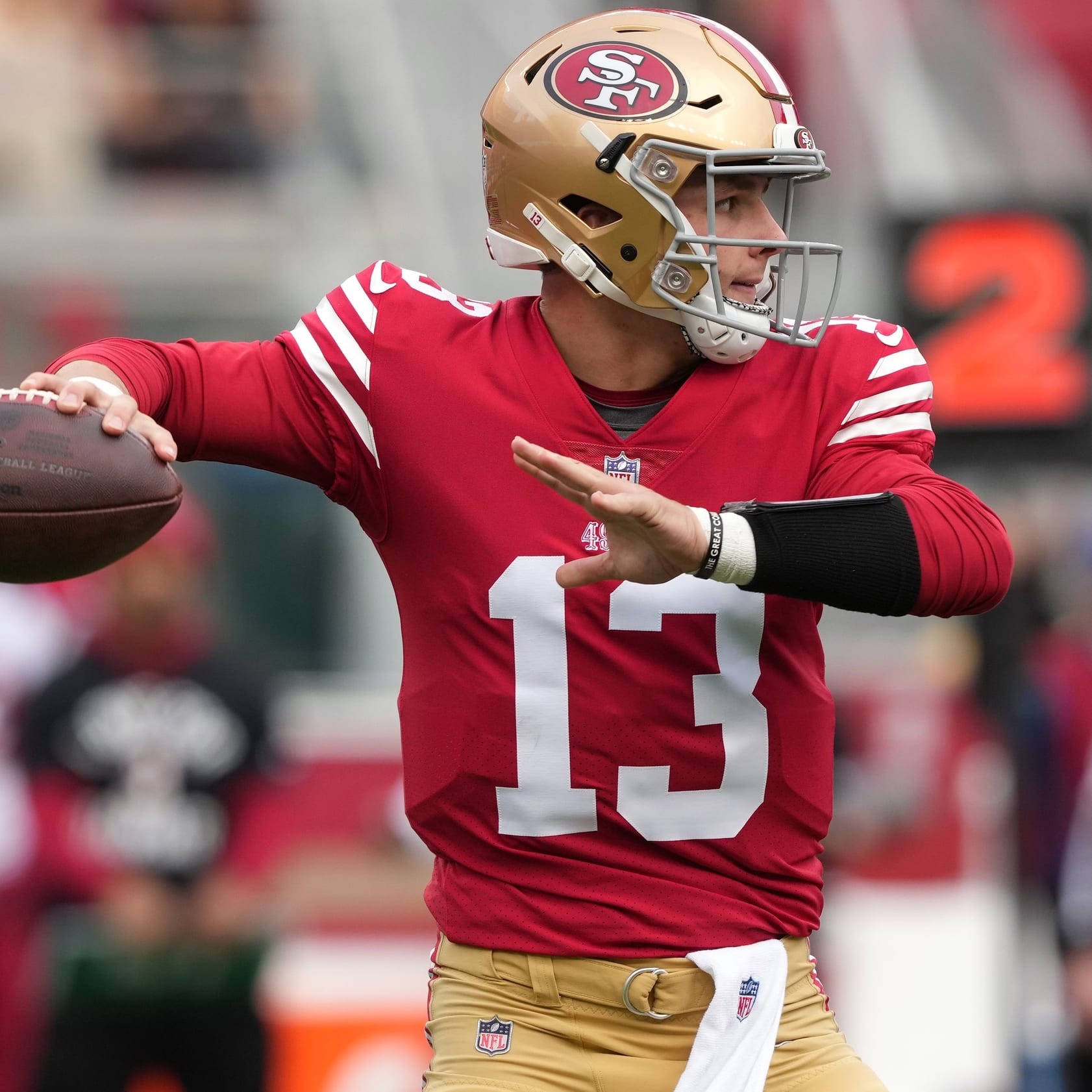There are a handful of impressive wide receiver prospects vying for the WR1 distinction in the 2022 NFL Draft – perhaps chiefly Drake London (USC), Jameson Williams (Alabama), Garrett Wilson (Ohio State), Chris Olave (Ohio State) and Treylon Burks (Arkansas) – but London (6-foot-4) is the only one above 6-foot-2 (Burks). More generally, London is the only receiver in this draft over that height who posted workhorse production in college. North Dakota State's Christian Watson is 6-foot-4, but he's lighter (208 pounds) than London (219) and was more of an alley-oop specialist than the foundation of his offense. By contrast, London is a big receiver who carried his offense, which makes him novel even in this strong receiver class.
With a narrow category comes a small sample of case studies, and the smaller the sample the easier it is to recall any given anecdote and misunderstand its significance. In London's case that means it's easy to watch and see glimpses of both good and bad NFL wide receivers, because both fairly apply given our absence of clarifying case studies. It's completely reasonable for a person to compare a London rep with both a good-case scenario like Mike Evans and a bad-case one like N'Keal Harry. As an NFL prospect London might be something like the data point halfway between Evans and Harry on a spectrum.
More specifically, all of London, Evans and Harry fit into the category of big, workhorse wide receivers who produced high volume at an early age with efficiency well above their team's base line. They also all fit into the category of receivers who made many catches in traffic. Evans, of course, carried these traits into the NFL and swiftly embarked on a Hall of Fame trajectory, whereas Harry crashed and imploded in pitiful fashion. This article will speculate London's NFL projection and try to map out how he fits relative to Evans and Harry, especially the latter.
PRODUCTION
A receiver's production level will generally give an insight to their skill as a receiver. Granting occasional exception due to scheme and circumstance, a good receiver will usually produce standout volume on standout efficiency without the aid of an age advantage over his competition. Unfortunately, exceptions exist in both directions – sometimes we'll miss a good NFL receiver because he didn't produce well in college, and sometimes a prospect will struggle in the NFL despite outproducing their peers in college. In the latter cases we can probably reason that their standout production was dependent on a physical or schematic advantage in college that did not exist in the NFL, at which point they simply hit a dead end.
Harry's NFL career has been a memorable example of this. Harry's dreary early NFL career is littered with incomplete passes that would have been big downfield receptions in college. The crash collisions and 50-50 jumpballs that bounced his way at Arizona State have done the opposite with the Patriots. With that said, London's production at USC was safely better than Harry's at Arizona State, and in that superior production could be indication of some distinguishing trait between London and Harry – one that would allow London to succeed in the NFL despite whatever other similarities the two might have.
Harry arrived to Arizona State with tons of recruiting hype, and he mostly validated that hype by emerging as their lead receiver in his true freshman season over esteemed then-senior Tim White. Despite the strong volume Harry's efficiency wasn't good that year – his 59.8 percent catch rate at 6.8 yards per target was below the team baseline of 60.5 percent completed at 7.3 yards per attempt. This is totally forgivable since Harry was a true freshman, but it's worth remembering this point because it's one that diverges from London's case. London was far above USC's base line in each of his three seasons, whereas in Harry's freshman year he was below the team base line and notably much less efficient than White (64.4 percent caught, 8.2 yards per target).
It was over the next two seasons that Harry's profile really took off. Beginning his sophomore year he turned a corner in his development as a college receiver, catching 155 of 236 targets for 2,230 yards and 17 touchdowns in 25 games. He produced a staggering 35.9 percent of Arizona State's receiving yardage and 42.5 percent of their receiving touchdowns on only 30.2 percent of the team target volume. He posted that usage share even while drastically outperforming the Arizona State baseline, catching 65.7 percent of his targets at 9.5 yards per target on an offense that completed 62.9 percent of its attempts at 8.0 yards per attempt. To produce that volume share while outplaying the catch rate base line by 2.8 points and yards per attempt base line by 1.5 points is hugely impressive for an underclassman. If production alone couldn't save Harry then it can't be trusted to save London, either, but it's worth noting first a couple areas their production was not the same.
The first is the one previously mentioned – Harry's efficiency stats as a true freshman were below the Arizona State base line, whereas London's were perfectly clean. London caught 39 of 54 targets that year for 567 yards and five touchdowns, good for a catch rate of 72.2 percent at 10.5 yards per target in an offense that completed 71.0 percent of its passes at 8.5 yards per attempt. Granted, London's yardage share (13.0 percent) was significantly less than Harry's (21.2), but it might be silly to hold that against London too much when he was playing on the same team as Michael Pittman and Amon-Ra St. Brown, who are respectively about 3.75 and 1.75 years older than London. London also had to contend with Tyler Vaughns, who is more than four years older. If anything, London's 13.0 percent yardage share against that group is impressive, especially since he was only about 18.1 at the time. Harry was notably older his freshman year, turning 19 the December after.
That age detail is the second point. It might not seem like much of a difference – London at 18.1 as a true freshman versus Harry at about 18.7 – but if the ages of two players are more than a half year apart then one of them is old for their class. Harry was nearly the age as a true freshman that London wouldn't turn until July 24 following his freshman season, which was about a month before the start of his sophomore year. If London had been nearly 19 as a true freshman instead of 18 then his numbers would have probably been even better yet across the board than they already were and again, they were already better than Harry's.
That leads to the third point: even without adjusting for age, London was more productive than Harry in each of their respective freshman, sophomore and junior seasons. It's true that Harry was a conventionally productive player in all of his three collegiate seasons, yet at his best he was still never as productive as London. Harry really took off in his sophomore and junior years. London played 14 games over his sophomore and junior years – six of them with St. Brown and Vaughns – and he completely torched. Drawing 32.7 percent of USC's targets in the sample, London produced 41.5 percent of their receiving yardage. On a team that completed 65.4 percent of its passes at 7.4 yards per attempt, London caught 71.2 percent of his targets at 9.3 yards a pop. Harry's production at Arizona State was strong, but London's is rare.
AESTHETIC
While they might all fit under the category of big receivers who excel at contested catches, London, Harry and Evans appear and function completely differently. Their playing styles, the specific functions they offer, their athletic traits, etc. Evans' sum of traits allowed him to transcend the category while Harry couldn't, and the question is whether London has enough positive traits to do the same. Evans is at once an example of what London can't be – Evans is too much bigger (6-foot-5, 231 pounds) and more athletic – yet might serve as an instructing example of why London can succeed in the NFL and Harry can't.
As much as London can't match Evans' compelling size-adjusted speed (4.53-second 40), it's not a speed distinction that separates Evans from Harry. Harry ran a 4.53 40 himself, after all, and at a comparable 228 pounds. There is a distinguishing detail in their movements that isn't captured by athletic testing, yet we can suspect it exists on the basis of their diverging career outcomes. One possible explanation lies in the way the three receivers move – specifically the degree of flexibility in their movements. Evans and London are very flexible and agile for how big they are to the point that they sometimes don't appear as big as they actually are, whereas Harry is invariably bulky and runs like it.
There's a term you'll see sometimes in scouting reports, 'Playing to Size,' and you probably most often see it in a negative context: the complaint that a prospect plays more like someone smaller than himself. In this case we might have an instance where it's a positive to play smaller than you are, at least when running routes. While you see many snaps where Evans and London alter their lean and direction with gymnastic-like grace and agility, Harry looks like an upright, burly person at nearly all times in all of his career snaps. He doesn't get low in his breaks or get small to swerve around a jam – he's always a brutish sort of presence with a heavy and stiff upper body.
Rather than appearing his actual size at all times, London only plays big when it's useful. He looks 6-foot-1 in his release and route, but when the ball is in the air he starts to look 6-foot-4 all of a sudden. When being big is a hindrance, London is flexible enough to adjust. The more adjustments a receiver can make in response to coverage the better. It's possible that Harry largely dominated in college because he was too big and athletic for Pac-10 corners to stand up to him, and when the NFL presented the adjustment of neutralizing that strength with superior size and athleticism he had nothing else to counter with. If so, London might avoid that fate because he wins not just with contested catches, but also a high volume of catches where he created short-area separation underneath. Sure, London has some plays where just bowls over a smaller corner, but Harry pretty much only had plays like that going for him.
Another aesthetic difference you'll notice between London and Harry is that, while both of their catches were often contested, Harry's were distinctly more violent. Not all contested catches are equally contested, and many London receptions that might qualify as contested probably weren't very contested at all. The defenders might be nearby, but he still got whooped on the route. A defender hitting London right after a catch is not the same as a defender reaching the ball at the same time as London and clashing over it. The latter is more like what you see in Harry's collegiate tape.
CONCLUSION
This article is optimistic for London's NFL projection. He's not a blue chip prospect like Evans, and there are valid concerns over his similarities with an NFL failure like Harry, but not all concerns stand to scrutiny. There's visual evidence that London differs meaningfully and favorably from Harry, and their respective production numbers say the same with even less ambiguity. Perhaps London will fail in the NFL, but he shouldn't fail for the same reasons Harry did. London should be an above average starting receiver in the NFL within two years. If he isn't the WR1 in this class then it's likely just a positive testament to the rest of the class rather than an indictment against London. This guy posted more yardage than St. Brown in the abbreviated year they were both starters, and St. Brown has already proven himself a standout NFL starter. The odds are not in favor of London failing in the NFL.
The contested catch concern with London is of course a corollary of the concern that he lacks speed. Perhaps if he were faster he'd have Evans-like separation, but he isn't so he doesn't. London has one chance to hurt or help his case on that question with a pro day workout scheduled Friday, April 15. While anything is possible, it's unlikely that London runs any better than a 4.55 and with that the speed concern will understandably endure.
If London can succeed despite below average speed then that success would probably lie in the fact that London often plays smaller than he actually is. Even if he's slow, London has the size and ball skills to make defenses averse to leaving him in off coverage. This is when they would bring the corners up closer to the line of scrimmage, perhaps to jam more aggressively in order to stunt London's route. It's at this point that his shape shifting is useful, because it's easier to jam a bigger target. If London can keep getting clean releases underneath, he should continue creating short-area separation that allows him to chip away at the defense with short gains. After you throw a short route enough times, the defense will eventually be tempted to jump the route the next time they think they see it. Mixing in double moves or even occasional sideline fly routes would be an opportunity for London to hit the occasional downfield play when the defense attempts to adjust to the short threat he poses.
London might compare favorably to Keenan Allen. A bigger, potentially more athletic version. Allen is a player who proved a high-volume, high-efficiency NFL target despite no one ever mistaking him for a true downfield threat, and the hope is London will prove the same. Like Allen, London is a big receiver with a point guard-like ability to cross up a defender, and that one moment of separation might be all he needs to consistently wound the defense.
Projected round: 1 (Top 15)




































